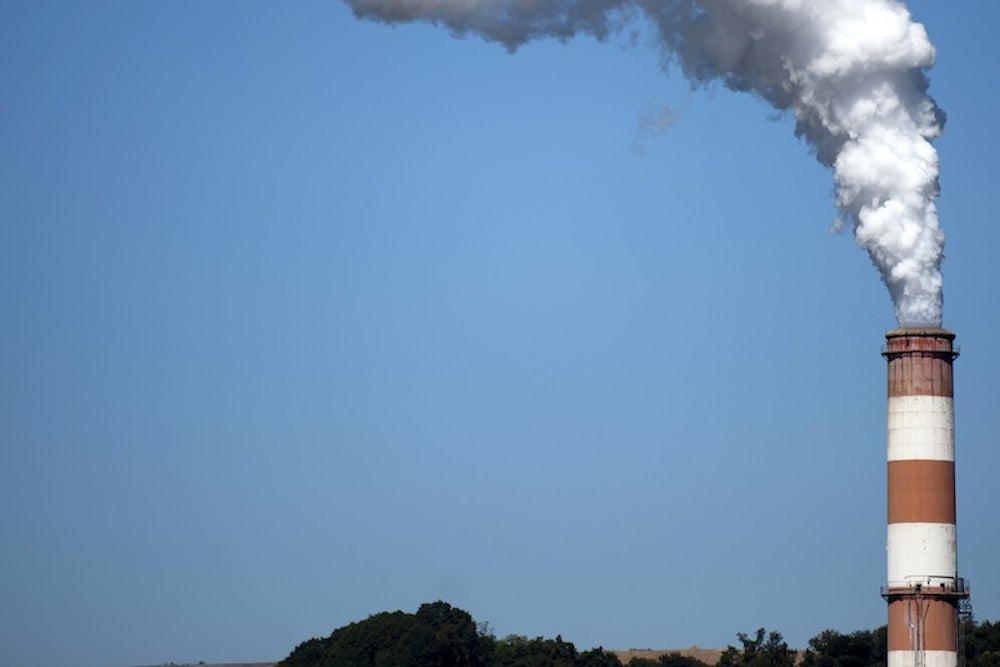The air you breathe is about to get a little cleaner. And for that you can thank Justice Ruth Bader Ginsburg.
The U.S. Supreme Court on Tuesday issued a key decision, written by Ginsburg, upholding a regulation called the Cross-State Air Pollution Rule. The “good neighbor rule,” as it’s come to be known, seeks to address air pollution that travels hundreds of miles away from its original source—say, from Ohio to New England—by requiring about 1,000 aging coal plans in 28 states to cut the harmful pollutants that create soot and smog. The Environmental Protection Agency administers the regulation, using authority it has from the 1972 Clean Air Act.
The ruling was a rebuke to the fossil fuel industry, which has fought these regulations, and to a lower federal court, which in 2012 rejected them as unconstitutional. It did not appear to be a close call. Chief Justice John Roberts and Justice Anthony Kennedy joined the decision, giving it the imprimatur of a six-justice majority. Justices Antonin Scalia and Clarence Thomas dissented, suggesting the pollution control scheme verged on Marxism. (Justice Samuel Alito recused himself, presumably because of a conflict of interest.)
The decision didn’t get a ton of attention outside of environmental circles. But it’s a bona fide big deal. Here are four reasons why:

1. Air pollution is a killer.
Simply put, the Supreme Court has effectively helped save lives. The EPA estimated that the rule in question would prevent up to 34,000 premature deaths, 15,000 non-fatal heart attacks, 420,000 respiratory symptom cases, and 400,000 aggravated asthma cases each year, mostly in the states that bear the brunt of the cross-state pollution. With this rule and other EPA air quality regulations still on hold, national air quality has actually grown worse. According to the American Lung Association’s State of the Air report, almost 150 million people breathe unhealthy air in 2014, an increase of 16 million since 2013.
2. Interstate pollution has stumped regulators for decades.
The federal government has recognized pollution as an interstate problem since 1977, but the EPA has long struggled with exactly how to regulate power plant pollution carried by the wind. Far from straightforward, interstate pollution is “a dense, spaghetti-like matrix,” according to the EPA. The complex nature of wind patterns make determining a state’s exact impact on air quality in another state nearly impossible.
Ever since Congress strengthened the good neighbor provision for polluting states in 1990, the EPA has grappled with finding the right balance of fairness to the upwind and downwind states. A Bush administration version that allowed states to pay other states to cut pollution, rather than reduce their own, was thrown out in court for being too lenient on the worst offenders. The version proposed by Obama’s EPA takes a different approach: It uses modeling and a cost-benefit analysis to calculate a total budget of pollution an upwind state can produce in a year. Ginsburg’s decision called the EPA’s solution a “cost-effective allocation of emission reductions among upwind states.”
3. It affirms the EPA’s authority to carry out existing law properly.
The Supreme Court upheld a 1984 precedent, Chevron v. NRDC. In that case, the Court ruled that it would defer to an agency’s expertise over how to carry out vague laws passed by Congress. According to SCOTUSblog, Ginsburg noted the courts should defer to the EPA’s expertise on exactly how to account for “the vagaries of the wind.”
This certainly won’t be the end of legal challenges that accuse the EPA of overreach, but the decision was another affirmation of the EPA’s authorities granted by the Clean Air Act.
4. It helps fight climate change.
In the U.S., coal plants account for 40 percent of the greenhouse gas emissions driving climate change. Because of this and other pollution regulations kicking in soon, companies will install pollution controls in some of those plants. They will shut down some others altogether, in part because cheap natural gas will make the coal plants less competitive.
But bigger changes may be coming. In June, the EPA will propose its first-ever limits on carbon pollution from power plants. Those regulations could represent the Obama Administration’s biggest, most important step to combat climate change. They are supposed to bring the U.S. into compliance with emission standards set by the so-called Copenhagen accords—which, in turn, is necessary in order to start negotiations over stronger global efforts to reduce global warming. But there is still much uncertainty surrounding the regulation. Among the big questions: Can it survive legal challenges from the fossil fuel industry?
Tuesday’s decision suggests even this conservative court may be inclined to support such regulatory efforts. Note that the case is one of a few legal victories scored by the Obama administration’s EPA in recent weeks. A federal appeals court upheld another EPA rule that reduces the level of mercury pollution emitted by coal-fired plants—a second key initiative from Obama’s first-term climate program.
